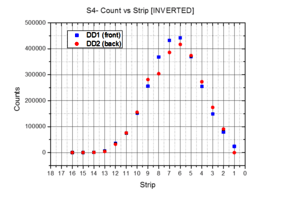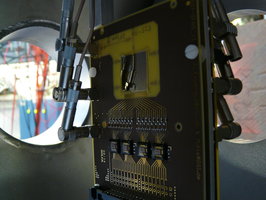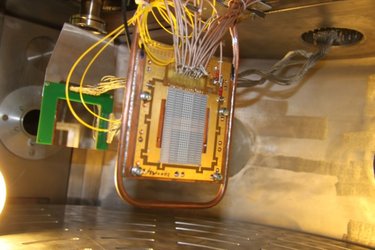Time of flight
Fast Time-of-flight (ToF) detectors are devoted to measure the fragment velocity between the mid-focal plane of the main separator and the ends of the branches [1].
The use of materials which survive Super-FRS beam rates longer than plastics (typically lifetime 1 week) is under investigation. As start/stop detector for ToF measurements, two prototypes made by polycrystalline diamond material produced by chemical vapor deposition (CVD) by Element Six (UK) having a modular planar geometry 20x20x0.3 mm3 have been tested at the FRS. They have been equipped with 16 vertical strips of 1 mm width separated by a gap of 0.15 mm. The Cr/Au electrode metallization (50/100 nm) via photolithography followed by etching was made at GSI. A new printed circuit board with PADI7 chips has been fabricated in house to readout each strip (see figure below). The digital output signal from the PADI could be sent to VFTX synchronized with a 200 MHz external clock.
[1] C. Nociforo, 2014 JINST 9 C01022
A ToF resolution of 40 ps, well in agreement with the goal design, was measured with DD1 and DD2 detectors close each other using 197Au beam at 900 MeV/nucleon. The resolution was 46 ps when DD2 was positioned 35 m apart [2]. No dependence on the beam rate over the range 0-30 kHz was found. The same detectors was also tested and irradiated with 12C beams at 62 MeV/nucleon at LNS-INFN, Catania. After an irradiation of 3.5x1012 ions/cm2 neither degradation of the signals was observed nor leakage current changes [3].
[2] F. Schirru et al., J. Phys. D: Appl. Phys. 49 (2016) 215105
[3] C. Nociforo et al., EPJ Web of Conf. 117, 10007 (2016)
The feasibility of time measurements was checked also for silicon detectors. A single-sided full size (40 cm2) silicon detector 0.3 mm thick made of strips (1 mm pitch) was irradiated with argon beam at 40.5 MeV/nucleon with an intensity up to 2x109 ions/s at Flerov laboratory JINR, Dubna. The detector has been operated in vacuum (10-6 mbar) and cooled down. One detector strip was connected to a fast oscilloscope without amplification. After irradiation of 2.2x1011 ions/cm2 the signal slope of the strip has showed a small degradation (<10%). In 2014 and 2016 a large size Si-strip prototype, shown below, was tested with a PADI6 board using a gold and uranium relativistic beams. Using PADI6 with the VFTX an excellent timing resolution of 18 ps (sigma) was achieved [4].
[4] V. Eremin et al., Nucl. Instr. and Meth. A 796 (2015) 158
Partners: IOFFE St. Petersburg and GSI






